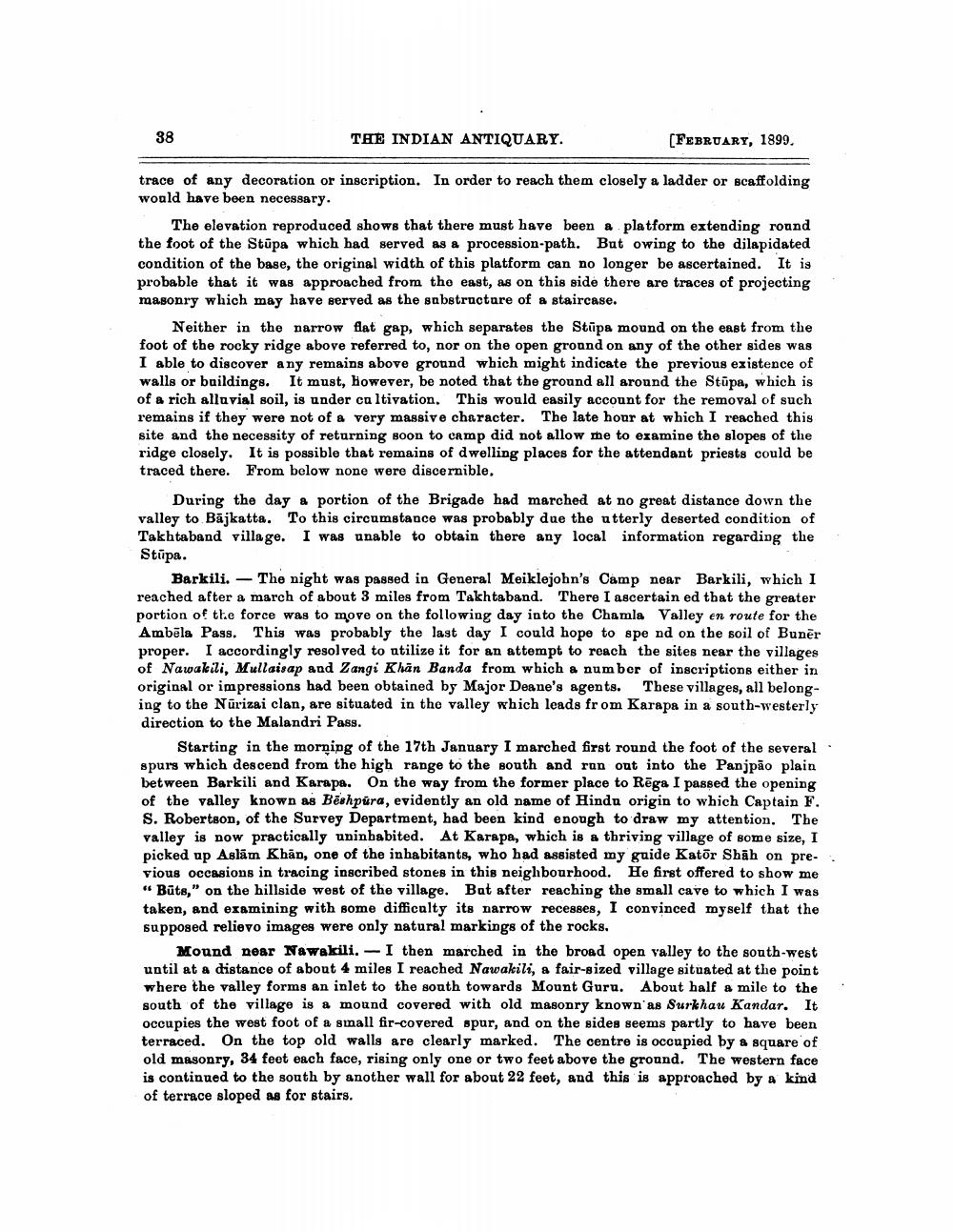________________
38
THE INDIAN ANTIQUARY.
(FEBRUARY, 1899.
trace of any decoration or inscription. In order to reach them closely a ladder or scaffolding would have been necessary.
The elevation reproduced shows that there must have been a platform extending round the foot of the Stūpa which had served as a procession-path. But owing to the dilapidated condition of the base, the original width of this platform can no longer be ascertained. It is probable that it was approached from the east, as on this side there are traces of projecting masonry which may have served as the substructure of a staircase.
Neither in the narrow flat gap, which separates the Stüpa mound on the east from the foot of the rocky ridge above referred to, nor on the open ground on any of the other sides was I able to discover any remains above ground which might indicate the previous existence of walls or buildings. It must, however, be noted that the ground all around the Stūpa, which is of a rich alla vial soil, is under ca ltivation. This would easily account for the removal of such remains if they were not of a very massive character. The late hour at which I reached this site and the necessity of returning soon to camp did not allow me to examine the slopes of the ridge closely. It is possible that remains of dwelling places for the attendant priests could be traced there. From below none were discernible.
During the day a portion of the Brigade had marched at no great distance down the valley to Bājkatta. To this circumstance was probably due the utterly deserted condition of Takhtaband village. I was unable to obtain there any local information regarding the Stūpa.
Barkili. - The night was passed in General Meiklejohn's Camp near Barkili, which I reached after a march of about 3 miles from Takhtaband. There I ascertain ed that the greater portion of the force was to move on the following day into the Chamla Valley en route for the Ambēla Pass. This was probably the last day I could hope to spe nd on the soil of Buner proper. I accordingly resolved to ntilize it for an attempt to reach the sites near the villages of Nawakili, Mullaisap and Zangi Khan Banda from which a number of inscriptions either in original or impressions had been obtained by Major Deane's agents. These villages, all belonging to the Nūrizai clan, are situated in the valley which leads from Karapa in a south-westerly direction to the Malandri Pass.
Starting in the morning of the 17th January I marched first round the foot of the several spurs which descend from the high range to the south and run out into the Panjpão plain between Barkili and Karapa. On the way from the former place to Rēga I passed the opening of the valley known as Bēshpura, evidently an old name of Hindu origin to which Captain F. S. Robertson, of the Survey Department, had been kind enough to draw my attention. The valley is now practically uninbabited. At Karapa, which is a thriving village of some size, I picked up Aslām Khān, one of the inhabitants, who had assisted my guide Kator Shāh on pre.. vious occasions in tracing inscribed stones in this neighbourhood. He first offered to show me " Būts," on the hillside west of the village. Bat after reaching the small cave to which I was taken, and examining with some difficulty its narrow recesses, I convinced myself that the supposed relievo images were only natural markings of the rocks.
Mound near Nawakili. - I then marched in the broad open valley to the south-west until at a distance of about 4 miles I reached Nawakili, a fair-sized village situated at the point where the valley forms an inlet to the south towards Mount Guru. About half a mile to the south of the village is a mound covered with old masonry known'as Surkhau Kandar. It occupies the west foot of a small fir-covered spur, and on the sides seems partly to have been terraced. On the top old walls are clearly marked. The centre is occupied by & square of old masonry, 34 feet each face, rising only one or two feet above the ground. The western face is continued to the south by another wall for about 22 feet, and this is approached by a kind of terrace sloped as for stairs.




